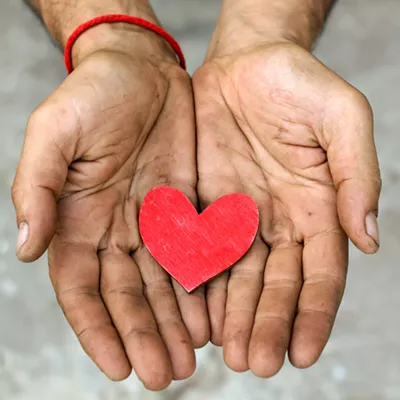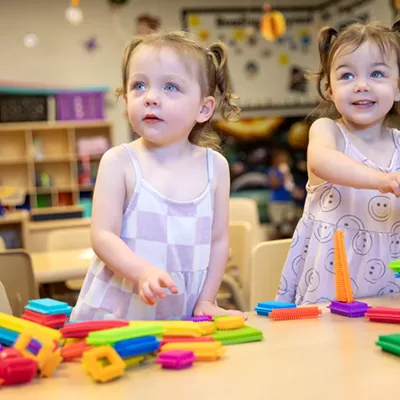On Monday, March 9, Tucson Mayor Regina Romero appeared with Pima County Supervisor Richard Elías and other community leaders at a press conference to urge the community to remain calm as COVID-19 outbreaks began to spread in hot spots across the country.
"I want to emphasize that both city and county have protocols in place to deal with exactly this kind of situation and are fully prepared and ready to respond when the virus presents itself in our region," Romero said. "We do expect and are fully prepared for the virus' eventual presence in our region. As with other illnesses, sticking to the basics can always go a long way. Washing your hands constantly, covering your cough and staying home if you're not feeling well will keep yourself and those around you healthy."
By Thursday, March 12, with just one confirmed case in Pima County, Romero urged much more dramatic steps via a taped message: It's time to stay home as much as possible and slow the inevitable community spread of the novel coronavirus that has crippled communities across the globe when it has spiraled out of control and overwhelmed healthcare systems.
Romero said she was recommending that any event with more than 50 people be postponed and said the city would not issue permits for special events with an expected attendance of 50 or more. She suspended all public meeting, meetings of boards, committees and commissions, as well as water service shut-offs by the city-owned Tucson Water. She extended sick leave policies for city employees, canceled their out-of-city travel for city employees and said the city was looking into telecommuting options.
"The sooner we take decisive action, the better off our community will be," Romero said.
And on Tuesday, March 17, Romero went even further, calling for the closure of all bars, restaurants, gyms and other places where more than 10 people congregate. (Takeout service from restaurants will still be available.)
Things have changed dramatically in the region in recent days. Gov. Doug Ducey and State Superintendent of Public Instruction Kathy Hoffman have announced that all Arizona K-12 schools would be closed at least through Friday, March 27. The University of Arizona, like ASU and NAU, has canceled classes and turned to online instruction to complete the spring semester, and Pima Community College has followed suit. Community leaders in Oro Valley and Marana have canceled public meetings and closed their council meetings to the public, although citizens can still view the proceedings online.
There's been a cascade of cancellations of community events. Everything from the Festival of Books and the Fourth Avenue Street Fair to home tours and gallery openings have shut down. Venues such as the Rialto and Fox theaters have gone dark. The NCAA March Madness tourney has been canceled and Major League Baseball has pushed back opening day by at least eight weeks, with other sports leagues—including Tucson's minor-league hockey team, The Roadrunners, and its Indoor Football team, the Sugar Skulls—suspending their seasons. People are hitting groceries and big-box retailers to stock up on staples such as pasta, beans and canned goods as worry about the future continues to grow.
This week, city officials were discussing the possibility of ordering the closure of bars and restaurants or limiting them to takeout service—a move that could cripple restaurants that often work on tight margins and leave waiters, bartenders and other restaurants workers out of jobs.
The worst is yet to come as COVID-19 spreads silently though Tucson. On Sunday, March 15, Dr. Bob England, interim director for the Pima County Health Department, warned that the number of confirmed community cases would begin increasing this week because more test kits have been distributed and private labs have begun testing. One of the reasons Arizona's numbers have been so low relates back to one of the central failings of the Trump administration as the virus has spread: The lack of test kits. Until late last week, Arizona only had 300 kits, so the criteria for testing was so narrow that many people with symptoms didn't qualify. As of Tuesday, March 17, only 221 people in Arizona had been tested, according to the Arizona Department of Health Services webpage.
England's comments on Sunday came hours after the third presumptive case was announced in the county, which he believes is the start of a communal spread of the virus.
"I suspect there are several intersections of people with mild illness, maybe people who don't even know they're sick at all, walking around in the community," England said. "That's why we're stressing so much about individual behavior about washing our hands and keeping our hands away from our face."
A fourth presumptive case of COVID-19 was confirmed in Pima County Monday morning, according to the Pima County Health Department. As of Tuesday morning, Arizona had a total of 20 cases, with 66 pending. None had been fatal.
COVID-19 may have made few Tucsonans sick so far, but the social and economic costs are already astronomical. With schools and many childcare facilities closed, parents are now scrambling for adequate childcare so they can continue working. In many cases, they may turn to grandparents to watch the kids—which, as England pointed out last week, puts the vulnerable above-60 population in harm's way if the kids happen to be carrying the virus without symptoms.
And with fewer people going out to movies, shows, restaurants and bars, those businesses—many of which operate on tight margins and count on a good spring ahead of the summer doldrums—are facing a grim future.
Moreover, with less shopping and dining comes less spending—and as a result, fewer sales tax dollars flowing to the city and state just as those people need more social services such healthcare and SNAP benefits.
Worse, this new normal may not be over any time soon.
"People have to understand that this won't be brief," England warned. "For these kinds of measures to have a good impact, they have to be in place for the duration of the outbreak. If you relax while the outbreak is going on, you'll see a surge of cases come back. So we all, as we plan ahead how we're going to deal with all this, have to realize that this may be in place for many, many months before we're out of this." ■
This article includes contributions from Austin Counts, Jeff Gardner and Kathleen Kunz.









